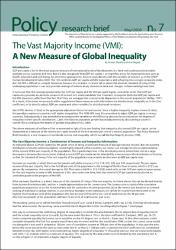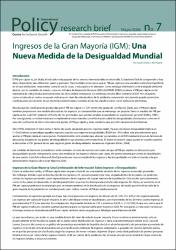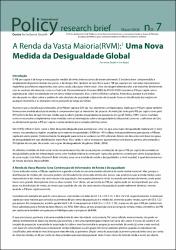Please use this identifier to cite or link to this item:
https://repositorio.ipea.gov.br/handle/11058/15879Full metadata record
| DC Field | Value | Language |
|---|---|---|
| dc.contributor.author | Shaikh, Anwar | |
| dc.contributor.author | Ragab, Amr | |
| dc.date.accessioned | 2024-10-04T00:11:29Z | - |
| dc.date.available | 2024-10-04T00:11:29Z | - |
| dc.date.issued | 2008 | |
| dc.identifier.uri | https://repositorio.ipea.gov.br/handle/11058/15879 | - |
| dc.description.abstract | GDP per capita is by far the most popular measure of international levels of development. It is fairly well understood and widely available across countries and time. But it is also recognized that GDP per capita is an imperfect proxy for important factors such as health, education and well-being. An alternative approach has been to work directly with the variables of concern, as in the UNDP Human Development Index (HDI). The HDI combines GDP per capita with life expectancy and schooling into a single composite index. But, the HDI is difficult to compile. Moreover, because it is an index, it cannot tell us about the absolute standard of living of the underlying population: it can only provide rankings of nations at any moment in time and changes in these rankings over time. It turns out that the rankings produced by the GDP per capita and the HDI are quite highly correlated. Given that GDP per capita also provides an absolute measure of income; it is understandable that it remains so popular. Both the GDP per capita and the HDI measures suffer from that fact that “they are averages that conceal wide disparities in the overall population” (Kelley, 1991). As a result, it becomes necessary to either supplement these measures with information on distributional inequality as in the Gini coefficient, or to directly adjust GDP per capita and other variables for distributional variations. Sen (1976) derives (1-Gini) as the appropriate adjustment factor for real income. Since a higher inequality implies a lower (1-Gini), this penalizes regions or countries with higher inequalities. The 1993 HDI used this procedure to adjust GDP per capita in various countries. Subsequently, it was extended to encompass the variables in the HDI using discount factors based on the degrees of inequality in their specific distributions. Later, the index incorporated gender-based adjustments by discounting a country’s overall HDI according to the degree of gender-inequality (Hicks, 2004). The above measures of welfare will be re-examined in light of our own finding that inequality-discounted GDP per capita can be interpreted as a measure of the relative per capita income of the first eighty per cent of a nation’s population. This Policy Research Brief introduces a new measure of worldwide income and inequality, which we call the Vast Majority Income (VMI). | en |
| dc.description.abstract | O PIB per capita é de longe a mais popular medida de níveis internacionais de desenvolvimento. É bastante bem compreendido e | pt-br |
| dc.language.iso | en | |
| dc.title | The Vast Majority Income (VMI): A New Measure of Global Inequality | en |
| dc.title.alternative | Ingresos de la Gran Mayoría (IGM): Una Nueva Medida de la Desigualdad Mundial | es |
| dc.title.alternative | A Renda da Vasta Maioria (RVM): Uma Nova Medida da Desigualdade Global | pt-br |
| dc.type | Policy Research Brief | |
| dc.rights.holder | International Policy Centre for Inclusive Growth | |
| dc.rights.holder | United Nations Development Programme | |
| dc.location.country | Brasil | |
| dc.description.physical | 4 p. : il. | |
| dc.rights.type | Licença total exclusiva | |
| dc.rights.license | O texto e dados desta publicação podem ser reproduzidos desde que as fontes sejam citadas. Reproduções com fins comerciais são proibidas. | |
| dc.subject.keyword | Vast Majority Income | |
| dc.subject.keyword | VMI | |
| dc.subject.keyword | Global Inequality | |
| ipea.access.type | Acesso Aberto | |
| ipea.researchfields | N/A | |
| ipea.classification | Ciência. Pesquisa. Metodologia. Análise Estatística | |
| ipea.classification | Economia. Desenvolvimento Econômico | |
| Appears in Collections: | Publicações do IPC-IG | |
Files in This Item:
| File | Description | Size | Format | |
|---|---|---|---|---|
| en_IPCPolicyResearchBrief7.pdf | 82.4 kB | Adobe PDF |  View/Open | |
| es_IPCPolicyResearchBrief7.pdf | 507.35 kB | Adobe PDF |  View/Open | |
| pt-br_IPCPolicyResearchBrief7.pdf | 521.76 kB | Adobe PDF |  View/Open |
Items in DSpace are protected by copyright, with all rights reserved, unless otherwise indicated.

